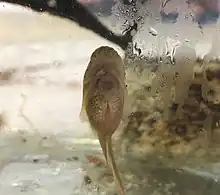| Liparis atlanticus | |
|---|---|
 | |
 | |
| Ventral sucker | |
| Scientific classification | |
| Domain: | Eukaryota |
| Kingdom: | Animalia |
| Phylum: | Chordata |
| Class: | Actinopterygii |
| Order: | Scorpaeniformes |
| Family: | Liparidae |
| Genus: | Liparis |
| Species: | L. atlanticus |
| Binomial name | |
| Liparis atlanticus (D. S. Jordan & Evermann, 1898) | |
| Synonyms[2] | |
| |
Liparis atlanticus, the Atlantic snailfish or Atlantic seasnail, is a species of marine ray-finned fish belonging to the family Liparidae, the snailfishes. This species is found in the western Atlantic Ocean off the eastern coast of North America.
Taxonomy
Liparis atlanticus was first formally described as Neoliparis atlanticus in 1898 by the American ichthyologists David Starr Jordan and Barton Warren Evermann with its type locality given as Godbout in Quebec.[3] Some authorities place this species in the subgenus Neoliparis,[4] while other include it in the nominate subgenus of Liparis.[5]
Description
Liparis atlanticus is a small tadpole-like fish with a soft, scaleless body and complex ventral sucker formed from heavily modified pelvic fins.[6] It has a single dorsal fin which is clearly incised at the 5th or 6th ray and the fins have comparatively ferwer fin rays than its congeners. The overall color is brown, lightening on the flanks and pale on the ventral surface with some black spots on sensory pores and barring on the fins.[7] This species reaches a maximum length of about 13 cm (5.1 in).[2]
Distribution and habitat
Liparis atlanticus are found in the coastal waters of the northwest Atlantic Ocean, ranging from Ungava Bay in Quebec[2] to New Jersey.[7] The Atlantic snailfish lives in intertidal zones and the immediately subtidal region to depths of 90 m (300 ft).[2] In northern parts of its range, it is often found along the shoreline in seaweed beds.[7]
Biology
Liparis atlanticus attains sexual maturity in their second year when they reach a length of 60 to 70 mm (2.4 to 2.8 in). They migrate into intertidal areas from mid-October prior to spawning in March and moving out of the intertidal zone in June. The males select and prepare a spawning site. The larger females have been recorded as spawning several times in a season, they deposit several small egg masses which the male fertilizes and collects into a single mass. This mass is hidden among stones and algae. Their diet is mainly polychaetes and crustaceans.[7]
References
- ↑ "Liparis atlanticus Atlantic Seasnail". NatureServe Explorer. NatureServe. Retrieved 22 March 2023.
- 1 2 3 4 Froese, Rainer; Pauly, Daniel (eds.) (2023). "Liparis atlanticus" in FishBase. February 2023 version.
- ↑ Eschmeyer, William N.; Fricke, Ron & van der Laan, Richard (eds.). "Species in the genus Liparis". Catalog of Fishes. California Academy of Sciences. Retrieved 22 March 2023.
- ↑ Chernova, N.V. (2022). "Amphiboreality and Distribution of Snailfishes (Cottiformes: Liparidae) in the Arctic and the North Atlantic". Diversity. 14: 1097. doi:10.3390/d14121097.
- ↑ Christopher Scharpf & Kenneth J. Lazara, eds. (4 October 2022). "Order Perciformes (part 22): Suborder Cottoidei: Infraorder Cottales: Family Liparidae". The ETYFish Project Fish Name Etymology Database. Christopher Scharpf and Kenneth J. Lazara. Retrieved 22 March 2023.
- ↑ Budney, L. A. & Hall, B. K. (2010). "Comparative morphology and osteology of pelvic fin-derived midline suckers in lumpfishes, snailfishes and gobies". Journal of Applied Ichthyology. 26 (2): 167–175. doi:10.1111/j.1439-0426.2010.01398.x.
- 1 2 3 4 Able, K. W. and D. E. McAllister (1980). "Revision of the snailfish genus Liparis from Arctic Canada" (PDF). Canadian Bulletin of Fisheries and Aquatic Sciences. 208.
- "Fishes of the World". Alwyne Wheeler.
- "The Inland Fishes of New York State." C. Lavett Smith.
